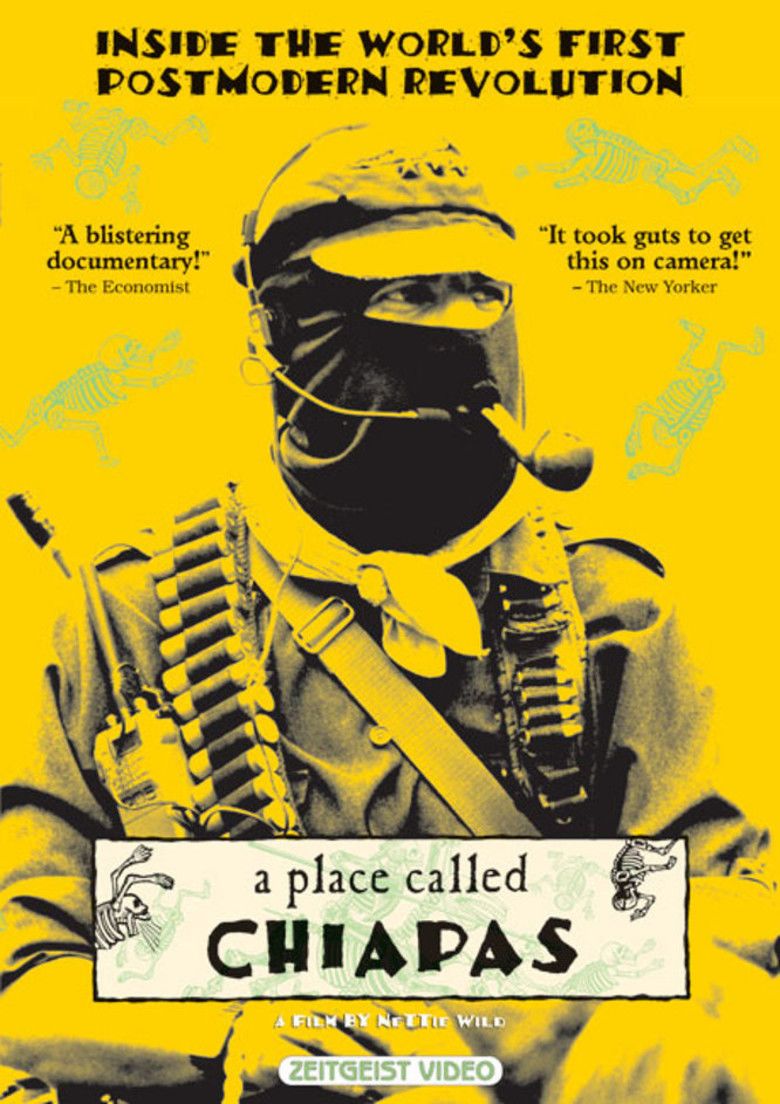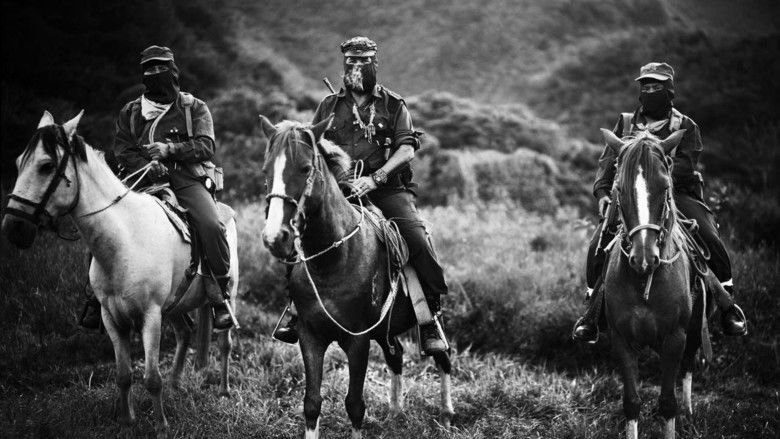A Place Called Chiapas
8 /10 1 Votes8
86% Rotten Tomatoes Genre Documentary Country Canada | 7.5/10 IMDb Duration Language English | |||||||||||||||||||||||||||||||||
 | ||||||||||||||||||||||||||||||||||
Cast Samuel Ruiz Release date 7 May 1998 (Germany) Awards Genie Award for Best Feature Length Documentary Similar movies The People of the Kattawapiskak River (2012), Hi-Ho Mistahey! (2013), First Contact (1982), Trick or Treaty? (2014), The Revolution Will Not Be Televised (2003) Tagline Inside the world's first postmodern revolution | ||||||||||||||||||||||||||||||||||
Documentarian Nettie Wild tells the story of the Zapatista National Liberation Army, which took over several indigenous villages and ranches in Mexico in 1994. For nine months, Wild and his crew travel around Chiapas, one of the Mexicos poorest regions and a stronghold of the rebellious group. The film focuses on the areas impoverished citizens and their deplorable living conditions, and includes a rare interview with the separatists reclusive leader, Marcos.
Contents
- North American Free Trade Agreement
- Chiapanec leadership
- Federal Army counter attack
- El Encuentro
- Peace and justice
- References

A Place Called Chiapas is a 1998 Canadian documentary film of first-hand accounts of the Ejercito Zapatista de Liberacion Nacional (EZLN) the (Zapatista Army of National Liberation or Zapatistas) and the lives of its soldiers and the people for whom they fight. Director Nettie Wild takes the viewer to rebel territory in the southwestern Mexican state of Chiapas, where the EZLN live and evade the Mexican Army.
On January 1, 1994, the Zapatista National Liberation Armymade up of impoverished Mayan Indians from the state of Chiapastook over five towns and 500 ranches in southern Mexico. The government deployed its troops, and at least 145 people died in the ensuing battle. Fighting for indigenous Mexicans to regain control over their lives and the land, the Zapatistas and their charismatic leader, guerilla poet Subcomandante Marcos, began sending their message to the world via the Internet. The result was what THE NEW YORK TIMES called "the world’s first postmodern revolution." Years into the uprising, filmmaker Nettie Wild traveled to the jungle canyons of southern Mexico to film the elusive and fragile life of the rebellion. Her camera effectively and movingly captures the personal stories behind a very public clash of traditional culture and globalization.
North American Free Trade Agreement
In 1993, the Mexican Federal Government signed the North American Free Trade Agreement (NAFTA) with the United States, effectively communicating to the Mexican people that allowing unimpeded American business penetration of Mexicos economy would promote Mexico from the Third-World to the First-World. Skeptical of these claims and their resulting implications, the Zapatista Army of National Liberation simultaneously arose in armed insurrection throughout the rural region of Chiapas on New Years Day 1994—capturing four municipalities (25 per cent of the state); to date, Chiapas is economically and politically, socially and militarily unsettled.
The nationalist EZLN insurrection arose in response to the NAFTA-induced “dollarization”, and consequent (further) impoverishment, of Mexicos economy; the NAFTA did not provide wage increases or prices decreases. Thus, according to the documentary, Chiapass indigenous Maya people said: "Basta! [Enough!], we will take ourselves underground and wait to rise up, like corn". In Mayan traditional lore, the Maya are the people born from maize.
Chiapanec leadership
In 1994, the EZLNs indigenous Chiapanec soldiers marched from the jungle to the towns in armed insurrection to reclaim their land from the elite ruling minority. Thus did the Mexicans of the national Capital and of the provincial states awaken to a New Year 1994 loud with AK-47 gunfire. The EZLN seized six hundred and fifty private ranches that had displaced the native Chiapanecs; afterwards, they controlled a fourth of Chiapas.
In behalf of the EZLN Indian leadership, Subcomandante Marcos (Sub-Commander Marcos) said in Spanish: "Today there were attacks on four municipalities in Chiapas. This is an insurrection led by our organization, the Zapatista Army of National Liberation".
Federal Army counter attack
The Mexican Federal Army counter-attacked; meanwhile, demanding "Control over our lives and land", the Zapatistas published their social and land reform demands in the internet. In the event, after much ruthless fighting, the Mexican Army and the EZLN called an uneasy ceasefire and truce. The Mexican Army surrounded Zapatista communities, villages, and towns to hunt rebel commanders, as in the town of La Realidad; the Mexican Federal Army iterated its presence with twice-daily tank and truck patrols.
Unforeseen by the right-wing, Neoliberal PRI (Mexicos seven-decade-rule party), the Mexican economy collapsed when the NAFTA allowed the importation of very low-priced American corn, depressing the Mexican Pesos value to negative exchange rate levels, thereby provoking Mexicos greatest economic bailout, by foreign (i.e., American) banks to date; U.S. President Clinton authorised $50 billion in loans; Mexico was in hock to foreigners.
Moreover, in an official bank memorandum, the CHASE Manhattan Bank (a leading bailout financier) told the Mexican Federal Government to "get rid of the Zapatistas" in exchange for full bailout financing. With a U.S. bank ordering the Mexican PRI-Government about, the Zapatistas said "they have no idea with whom they are negotiating" — the lender or the borrower.... Who is owner of Mexico?
El Encuentro
For the Zapatistas, "El Encuentro" [The Encounter] against Neoliberalism and for all of humanity, was a peaceful mode of obtaining international support and resistance aid. Director Wild considers it "a post-Glasnost revolutionary Woodstock, without the Acid". Three thousand people attended El Encuentro, among them Spanish anarchists, Italian communists, Latin American revolutionaries, Chiapanec Indians, and Superbarrio [Super Neighbourhood], the caped professional wrestler and social activist. The Encuentro demonstrates the importance of civilian support to the Zapatista national liberation movement, whose goals the civilians of the world understand. The Encuentro featured a dance wherein Zapatistas and guests dance "on the edge of romantic ideals and harsh politics, between those who can leave Mexico and those who cannot"; many Zapatista supporters could not reach the Encuentro of 1996.
Yet, director Wild says:"A month before the Encuentro I encountered a group of people [whom] the revolution almost forgot. I followed dark rumours of fear and violence to the north of Chiapas, to Jomajl; here villages are deeply divided, between Zapatista supporters and villagers who work directly with the ruling party and profit from it".
Peace and justice
To wit, paramilitary mercenary groups named "Peace and Justice" fight the EZLN and its civil supporters; "Anyone who opposes them, they call Zapatistas. In northern Chiapas, the paramilitary mercenaries have, at gun-point, forced out thousands of people from their villages, farms, and ranches, thus rendering those Mexicans refugees in their own country. Documentarist Wild questions: "If they go home can or will the Zapatistas help them?"; she comments: "My camera is framing the gap between rhetoric and reality".
A month later, among three thousand people, she watches the horse-mounted Subcomandante Marcos appear from the jungle, holding a flagpole bearing a small red flag, he was "Reminiscent of the hapless Don Quixote — the fictional Spanish knight who fights for impossible dreams, and cant distinguish reality from whats inside his head".
In press conference, the documentarist Nettie Wild asks Subcomandante Marcos what is the Zapatista plan for their supporters in the north; he replies offensively, but later halts peace talks with the Mexican Federal Government until the north Chiapas refugees are served real peace and justice.
The documentary A Place Called Chiapas shows the startling reality of what is like to live in contemporary Chiapas, a relatively quiet war zone. The viewer must interpret and determine, for him- and herself, the true nature — social, political, military, of the Zapatista National Liberation Movement and its army, the EZLN.
References
A Place Called Chiapas WikipediaA Place Called Chiapas IMDbA Place Called Chiapas Rotten TomatoesA Place Called Chiapas themoviedb.org
